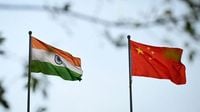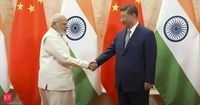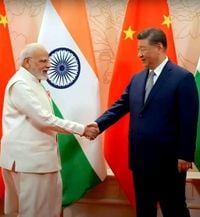In a high-stakes diplomatic engagement that could reshape the future of Asian geopolitics, Chinese President Xi Jinping and Indian Prime Minister Narendra Modi met in Tianjin on August 31, 2025, pledging to resolve longstanding border differences and expand cooperation. Their landmark meeting, held on the sidelines of the Shanghai Cooperation Organisation (SCO) Summit, marked Modi’s first visit to China since the deadly 2020 border clashes that plunged bilateral ties into a deep freeze.
Both leaders struck a conciliatory tone, emphasizing partnership over rivalry and the importance of peace along their disputed border. According to India’s Ministry of External Affairs, Modi stated, “There is a peaceful environment at the borders after disengagement,” underlining that tranquility in these regions is essential for the continued development of bilateral relations. Foreign Secretary Vikram Misri echoed this sentiment, telling reporters that Modi described peace along the border as “an insurance policy for bilateral relations.”
Xi, for his part, was equally optimistic. State broadcaster CCTV reported Xi’s hope that the Tianjin meeting would “further elevate” and “promote the sustained, healthy and stable development of bilateral relations.” He cautioned that the border issue should not define the entirety of China-India relations, urging both countries to focus on economic development as their main priority. “As long as they remain committed to the overarching goal of being partners, not rivals, and providing development opportunities, not threats, China-India relations will flourish and move forward steadily,” Xi said.
The summit’s timing was significant. Just weeks earlier, China’s top diplomat Wang Yi had visited New Delhi to announce a rapprochement, restart border talks, and resume direct flights and visa issuance between the two countries. This diplomatic thaw was already in motion, but the Tianjin encounter gave it dramatic new momentum. In June, Beijing had allowed Indian pilgrims to visit holy sites in Tibet, a gesture seen as a goodwill signal by many observers.
Beyond border issues, the leaders tackled a broad agenda. Modi raised the perennial concern of cross-border terrorism, urging both sides to support each other in tackling the problem. “Both India and China have suffered due to terrorism, making cooperation essential,” Modi said, with Misri confirming that China had extended understanding and cooperation on this front during the SCO Summit.
Trade and economic ties were another major focus. Both Modi and Xi acknowledged the vital role their economies play in stabilizing global trade. They agreed to expand bilateral trade and investment, while addressing the persistent trade deficit that has long been a matter of contention. As Misri put it, “Amongst other issues, the two leaders also exchanged views on ways to increase and balance bilateral trade, strengthen people-to-people ties.” Discussions on the trade deficit had already been ongoing since Foreign Minister Wang Yi’s August visit to Delhi, highlighting the seriousness with which both sides now approach economic cooperation.
The leaders also discussed connectivity projects with Myanmar, underlining their importance for India–Southeast Asia ties. Modi met with Myanmar’s acting President and military chief, Senior General Min Aung Hlaing, reviewing bilateral cooperation in development, defense, security, border management, and trade. Notably, Modi stressed that India supports a Myanmar-led and Myanmar-owned peace process, with peaceful dialogue as the only way forward.
On the global stage, Xi and Modi positioned their countries as pillars of the Global South and champions of multilateralism. Xi referred to turbulence caused by global trade and tariff policies, highlighting the need for India and China to work together to uphold a multipolar world. Both leaders agreed to “facilitate trade, reduce risks, and support stability in the global economy,” according to the Indian Ministry of External Affairs. Modi invited Xi to the 2026 BRICS Summit in India, and Xi reciprocated by expressing support for India’s BRICS leadership.
Russian President Vladimir Putin’s arrival in Tianjin added another layer to the summit’s importance. Putin reaffirmed Russia’s strong ties with China, noting “unprecedented” growth in bilateral trade since 2021 and highlighting China’s position as Russia’s top trading partner. In an interview with Xinhua, Putin said, “I look forward to in-depth discussions with President Xi Jinping on all aspects of our bilateral agenda... we will exchange views on pressing regional and international issues.” He pointed to over 100 billion cubic meters of Russian gas delivered to China via the Power of Siberia pipeline since 2019, with plans for a new route by 2027. Putin called the SCO a force for a “multipolar world order,” expressing hope that the summit would “inject powerful new momentum” and promote solidarity and fairness in global affairs.
While the summit was hailed as a diplomatic breakthrough by many, it also sparked political debate back in India. Opposition leaders, particularly from the Congress party, questioned whether the Modi government was too quick to reconcile with China after the 2020 Galwan Valley clash that claimed the lives of 20 Indian soldiers. Congress spokesperson Jairam Ramesh criticized the government, asking whether the “new normal” should be defined by “Chinese aggression and bullying and our Government’s spinelessness.” The Army Chief’s demand for a full restoration of the status quo on the border with China in Ladakh was also cited as an unresolved issue.
Other political voices, such as RJD MP Manoj Jha, raised concerns about China’s role during regional security operations and called for transparency regarding China’s intentions and actions. Nevertheless, the dominant narrative from the summit was one of cautious optimism, with both leaders reaffirming that India and China are “development partners, not rivals,” and that their differences should not turn into disputes.
In a symbolic gesture of unity, Modi and Xi joined other world leaders for a ‘family photo’ at the SCO Summit official reception, a moment capturing the spirit of cooperation that the summit sought to foster. Modi also met with Egyptian Prime Minister Mostafa Madbouly and Belarusian President Alexander Lukashenko, further underlining India’s commitment to regional and global partnerships.
As the summit concluded, Modi described the talks as “fruitful,” highlighting steady progress in bilateral relations since their last meeting in Kazan in October 2024. Xi thanked Modi for his support and reiterated the importance of India-China cooperation for the welfare of their combined 2.8 billion people—a sentiment Modi echoed, stating, “Our cooperation is linked to the interests of 2.8 billion people of our two countries. This will also pave the way for the welfare of all humanity.”
With the successful disengagement along the border, the resumption of direct flights, and renewed diplomatic engagement, the Tianjin summit may well mark the beginning of a new chapter in the complex relationship between Asia’s two giants. The coming months will reveal whether the promises made in Tianjin will translate into lasting peace and prosperity for the region.



